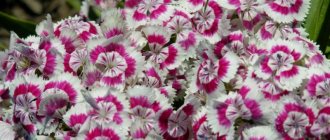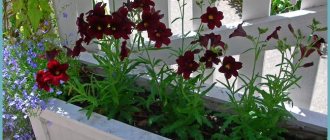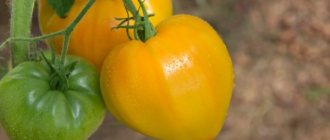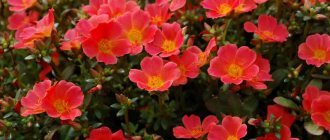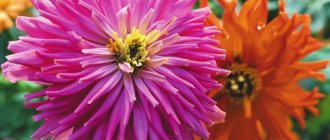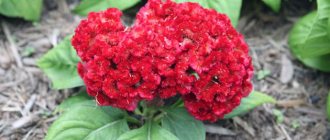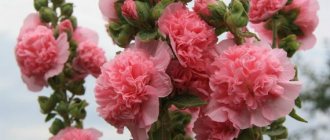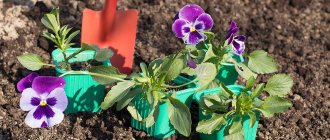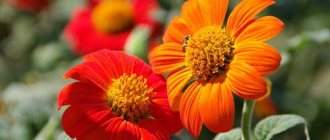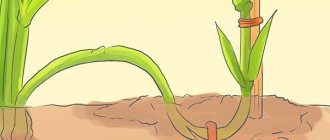Chinese carnation: types and varieties for open ground
Useful information about the beautifully flowering species:
- Carnation family;
- homeland - China;
- in European countries, Chinese cloves appeared in the 18th century;
- number of varieties - about three hundred;
- branched herbaceous bush;
- plant height – from 15 to 45–50 cm;
- flowering - from June to August;
- Chinese carnation is suitable for decorating gardens and balconies;
- flowers of different diameters: 1–4 cm, double, consisting of a group of petals with slits at the ends;
- various shades: lilac, white, purple, soft pink, deep burgundy.
More useful information:
- many hybrids have a contrasting shade of the edge of the petals and the middle part of the flower;
- narrow leaves resemble a lancet, placed oppositely, the shade is deep green;
- annual and perennial plants are quite unpretentious and have taken root well in different regions, except for zones with harsh climates;
- many species tolerate wintering without problems if the bushes are properly prepared;
- advantages of Asian terry carnations: highly decorative, planted not only in the garden, in flower beds, alpine hills, but also in flowerpots for decorating patios and balconies, can be grown for cutting. The plant is unpretentious and rarely gets sick;
- a suitable species for beginner gardeners.
Chinese cloves, photos, popular varieties:
- Diana.
- Terry mix.
- Super Parfait.
Flowers
Undoubtedly, this is the main decoration of the Chinese carnation (you can see the photo below). They can be simple, semi-double or double, single or collected in small inflorescences of three or four flowers, consisting of several petals, and not exceeding four centimeters in diameter. The smell is pleasant, but subtle.
The height of individual shoots of dwarf varieties is no more than 15 cm; other varieties can produce stems up to half a meter long. The plant blooms in pink, white, crimson, coral or cherry color. Some varieties combine several shades. In this case, the main color is complemented by a lighter or darker edging and core.
During breeding work, many hybrids were developed that are distinguished by compact bushes and long flowering. Such hybrids are very delicate and fragile, so all of them, as a rule, are grown as annuals.
Growing from seeds to seedlings
Effective method, good process efficiency: Chinese carnation has a high percentage of seed germination. When work with planting material begins in March, then in the second ten days of May you can transplant the picked seedlings to a flowerbed or to another place on the site.
Soil and container
For seedlings you will need a large plastic container with compartments or a wooden box. It is important that the container is deep and wide enough. The best option is to treat the containers with fungicides or a strong solution of potassium permanganate. Species from the Clove family do not tolerate the effects of putrefactive flora; it is necessary to protect seeds and future seedlings from the influence of pathogenic microorganisms.
The soil needs to be loose (add sand, 1 part) and nutritious (mix garden soil with peat in equal proportions, 2 parts each). It is useful to calcinate the soil for growing sprouts of Chinese terry carnation mix in the oven or treat it with the same means as the substrate.
Planting seeds
Procedure:
- First, the prepared soil is poured into disinfected containers, leveled, moderately watered with settled water, and wait until the moisture drains a little and the surface dries slightly.
- The seeds are planted shallowly: you just need to press the planting material slightly into the ground.
- Sprinkle the grains on top with a thin layer of damp substrate and spray them a little again.
- The greenhouse is covered with a plastic bag or glass, and the container is placed in a bright room with a moderate temperature: from +17 to +20 degrees.
- Every two days, open the greenhouse for 10 minutes, ventilate the substrate, and wipe off the condensation.
- Chinese carnation shoots appear in approximately 10–12 days.
- Over the course of two or three days, you need to gradually open the glass more and more, and on the fourth day, remove it completely so that the sprouts can breathe well.
Seedling care
The rules are simple, and the quality and strength of the seedlings depends on their compliance. At this stage, it is very important to adjust the temperature in the room: many novice gardeners place seedlings in a warm room, the sprouts grow ahead of time, which negatively affects the condition of the young carnation.
Recommendations:
- watering. Carefully, moderately add liquid under each seedling or from the edges of the box so that water does not accumulate near the sprouts. Do not use the liquid straight from the tap; be sure to let it sit for two days. The water is warm, you can add a little potassium permanganate if there are signs of rotting;
- temperature. After the seedlings form, the indicators are moderate so that the seedlings do not stretch too actively. You will have to find a cool place (+14..15°C) for a box or container with seedlings. It is important that at average temperatures there is no shortage of light, otherwise the risk of fungal diseases increases, especially with excessive watering;
- picking. Seedlings of double Chinese carnation mix do not differ in this indicator from most types of beautifully flowering plants: grown seedlings are planted when two or three true leaves appear. Peat pots, 200-300 ml containers of sour cream or yogurt are suitable container options for growing terry clove seedlings. It is useful to know how to choose a peat cup so that the young plant is formed in a high-quality, nutritious environment.
Transplanting
Grown and pruned seedlings are moved to the garden in the third or fourth decade of May. The frosts have stopped, it’s warm outside, there are all the conditions for growth and abundant flowering.
The soil is carefully dug up and loosened, weeds with roots are removed, and a little organic matter (peat or compost) is added before digging. The soil should be moist, loose, and the holes should be of medium size so that the planted bushes do not go too deep. The interval between neighboring plants depends on the variety: low-growing - about 20 cm, medium-growing - 25 cm, tall, lush bushes - 30-35 cm.
Important details:
- Terry carnation sprouts are planted on a day with light clouds and no rain.
- Strong wind and fog are factors that interfere with landing. After planting, young bushes are watered moderately.
- Many gardeners create a thin layer of mulch in the planting area to reduce moisture evaporation.
- It is enough to pour approximately 0.7 cm of peat. Mulching the soil is useful in regions where it rarely rains.
Planting seeds in open ground
Many varieties of Chinese carnations are not afraid of cold weather, and you can do without the stage of preparing seedlings. Planting time is mid-May, so that the soil warms up and the risk of frost decreases. The approximate timing of planting “seeds” depends on the region. Often the base that spilled onto the ground before harvesting the previous year germinates. Chinese carnation, with double, carved petals and a bright mix of colors, reproduces well by self-sowing.
Important landing details:
- for optimal growth of a spectacular flower, when using the seedless method, choose annual varieties;
- it is important that the soil warms up to +15°C, and the substrate on the site warms up to +20°C;
- a mandatory step is the use of succinic acid for plants. The seeds are placed in a solution prepared according to the instructions for 20 minutes, taken out and allowed to dry a little;
- the soil is pre-watered and thoroughly loosened;
- the treated planting material is combined with agrovermiculite, placed in holes, but deepened weakly: up to 2 cm, no more;
- as when growing seedlings, the area after sowing the seeds is covered with a transparent film, but only at night, unless there is a sharp drop in temperature. The second option is to make a small greenhouse;
- it is important that the soil is moist during the “black earth” period;
- in open ground, seedlings form later: after approximately 20–25 days. Sprouted elements must be thinned out in order to avoid dense plantings and reduce the risk of developing “black leg” in young plants.
Choice of location and lighting
Chinese double carnation loves sunny areas or areas with light shade. A suitable location has a high probability of abundant flowering. It is important that the soil is not swampy: the plant does not tolerate heavy, too wet soil, and fungus develops.
Carnations are not planted in a draft. You can place flowers in flowerpots, place them in the patio area or on the terrace.
It is convenient for residents of city apartments to grow the species in a flower pot, which is placed on a balcony with good lighting. If tall trees grow near the house and there is a lot of shade, then instead of Chinese Carnation, other, shade-tolerant and shade-loving species are placed on the spacious balcony: Fern, Monstera Liana, Ficus.
Picking seedlings
When growing Chinese cloves from seeds, you should pay attention to this procedure. When the seedlings have 2-3 true leaves, they need to be plucked. Young plants are transplanted into peat cups with nutritious soil. Before planting perennial Chinese carnations in open ground, it must become well established. To harden the seedlings, in good weather they can be taken out onto a glassed-in loggia or balcony.
If you plan to grow carnations as a houseplant, they are immediately planted in pots. When the seedlings have 4-6 true leaves, they need pinching, which ensures the splendor of the future bush.
Seedlings are planted in open ground in the middle or end of May, when the threat of return frosts has passed.
Outdoor care
There are no practical difficulties; knowledge of the basic recommendations for growing mixed Chinese cloves will help prevent mistakes. Confirmation of optimal care - “fresh”, beautiful-looking plants, good bushiness, an abundance of buds.
Watering
Adding moisture is required as the soil dries 1–2 cm. It is important that the substrate does not become crusty: simple procedures (loosening followed by mulching) maintain the best soil moisture.
Note! Chinese carnation is afraid of waterlogging: fungal diseases develop, plants wither and rot.
Feeding and fertilizer
You cannot overfeed a beautifully flowering species, but nutritional deficiency is also harmful. It is enough to apply complex mineral fertilizers to the soil two or three times a month. Before releasing buds and during the flowering period, be sure to slightly increase the concentration of potassium and phosphorus, and reduce nitrogen so that the green mass does not take too much juice from the plant. In the first year of life for perennial species, preparations containing calcium are not applied.
Many gardeners positively evaluate the effect of Biohumus - a safe and very useful product based on natural ingredients. Red Californian worms process compost, creating a nutrient medium and an effective biofertilizer. For Chinese cloves, you need Biogmus in liquid form.
Care during and after flowering
Be sure to water the plants, loosen the soil in a timely manner, and regularly feed the bushes with delicate buds. Fertilizers must contain potassium (most of it), phosphorus (about 2 times less) and a minimum amount of nitrogen so that the stems and leaves do not grow more actively than the flowers. It is important that the bushes receive enough light. It is useful to monitor the condition of the soil and pull out weeds as necessary.
For a more active release of new buds, carefully cut off elements with faded flowers.
Bush formation
It is useful to pinch the top of a double Chinese carnation: the plant bushes more actively and strong stems are formed. You cannot remove too many elements: the plant loses its decorative effect and may get sick. Effective biostimulants Epin, Zircon, Fitosporin are drugs with a complex of useful substances. The products reduce the effects of stress in garden and indoor plants. Immunomodulators are used before or after the procedure or the effect of negative factors, taking into account the requirements of the instructions.
Mulching, loosening
Simple and effective agrotechnical measures, thanks to which not only the double Asian carnation, but also the florist feel the benefits. Loosening enriches the substrate with oxygen, simultaneously fighting weeds, and mulching allows you to water the beautifully flowering species less frequently and spend less time destroying ubiquitous parasitic plants. The mulch layer should not be very thick: 0.5–0.7 cm is enough. Organic matter is suitable - crushed layers of peat.
Watering and fertilizing
Adult carnations should be watered sparingly, avoiding stagnation of water at the roots or on the tree trunk. It is optimal to add moisture once a week. This amount of water will be quite enough for the development of the plant and its stable flowering.
In order for the bushes to be lush, in addition to watering, they also require periodic feeding. To do this, use 20 grams of superphosphate diluted in 10 liters of water, and then use the resulting liquid for irrigation (Figure 6).
Note: Experienced gardeners recommend fertilizing 2-3 times per season. Then the flowers will be large, and the bushes themselves will be healthy and resistant to fungal diseases.
If we talk about choosing a preparation for feeding, then it is best to use complex fertilizers with a low nitrogen content. It is important to remember that an excess of this element will only provoke an increase in green mass, but will delay flowering. In addition, all fertilizers are applied only after watering, so that all nutrients dissolve in the soil faster.
Figure 6. Timely application of fertilizing is the key to long flowering
In the future, when the bushes begin to become covered with inflorescences, it is important to remove withered buds in a timely manner. This will make flowering more abundant and longer.
Protection from pests and diseases
The main reason for damage to plants from the clove family is improper care: the grower moisturizes the soil more actively than it should. If the region has not very hot summers, then swampiness combined with coolness often provokes the development of fungal diseases. Rust, root rot, fusarium, spotting are dangerous diseases, the success of combating which depends on timely and competent treatment.
What to do:
- remove rotten parts of plants as soon as possible (at the initial stage of damage) or dig up entire bushes;
- problem plants are disposed of (burned) so that the fungus does not spread further;
- destroy pathogenic flora using fungicides. They use Bordeaux mixture, drugs Skor, Fundazol, copper-containing products;
- carefully treat the leaves and stems, water the soil in the growth zone of the bushes;
- in case of severe fungal diseases, you will have to part with the Chinese carnation in the problematic flowerbed or flowerpot: it is important to remove all sources of infection and disinfect the soil. It is advisable to recycle the flower pot;
- All work is performed in closed clothing, thin rubber gloves, and a respirator. It is useful to wear plastic glasses to protect your eyes from accidental drops of antifungal drugs;
- It is advisable to renew the site every five years and plant cloves in a new place. You should not combine planting tulips and double carnations: infection with fungal infections is possible if the grower does not adhere to the rules of watering.
Useful information about pests and their control:
- When there is a lack of moisture, spider mites multiply on the cloves. Only the timely start of the fight saves the plantings from destruction: the parasitic species actively reproduces and interferes with the growth of bushes. Cobwebs, sticky secretions, damaged leaves and stems interfere with vital processes.
- First, the plants are sprayed, the soil is well watered, and pests are collected.
- To destroy tiny red-orange parasites, acaricides are used: Fufanon, Neoron, Antiklesch. The universal remedy of hazard class 2, Actellik, is also detrimental to spider mites, but the drug is used only after other, weaker remedies have failed.
- It is imperative to follow safety rules when processing plantings, to avoid inhaling vapors and contact with the liquid form of chemicals, especially toxic agents from the group of organophosphorus preparations (OPS).
Tips for caring for cloves
Most carnations are unpretentious plants that do not require any complex care. It is enough just to regularly cut off dried inflorescences to resume flowering (in remontant varieties) and preserve the decorative appearance of the bush.
Sometimes thaws have a negative effect: in thawed, sun-warmed places, carnations quickly begin to grow, and then frosts damage them. In the fall, experienced gardeners cover non-frost-resistant hybrids with cut stems of dahlias and peonies so that the branches lie freely. They hold the snow and protect the bushes from the sun.
Garden location and lighting . All carnations prefer well-lit places without stagnant water. They grow well among large stones and on slopes.
The soil . Carnations prefer fertile, neutral garden soil. They do not tolerate stagnant water. In areas with high groundwater levels, it is better to plant carnations in raised beds.
Fertilizer . Before flowering, you can apply complex mineral fertilizer, but you cannot use fresh manure.
Wintering . The pinnate carnation (Dianthus plumanus) is considered to be the most frost-resistant. All varieties that came from crossing with it are resistant to cold. It is believed that low and small-flowered carnations can overwinter without problems. Only severe frosts (-30-40) in the complete absence of snow can become dangerous for them.
Sometimes thaws have a negative effect: in thawed, sun-warmed places, carnations quickly begin to grow, and then spring frosts damage them. In the fall, experienced gardeners cover non-frost-resistant hybrids with cut stems of dahlias and peonies so that the branches lie freely. They hold the snow and shelter the bushes from the warming sun.
Reproduction
Chinese cloves are grown not only by seeds, but also by vegetative methods.
Dividing the bush
A simple method for varieties with a powerful root system. The positive thing is that many of the characteristics of the mother plant are preserved. The procedure is performed in the spring. The bush is carefully dug up, divided so that each part contains live buds (at least 3 pieces), and the plants are placed in the holes. Pre-treatment of roots with Zircon and Kornevin preparations activates the development of the underground part of new bushes. Biostimulants for plants reduce the effects of stress, in particular during transplantation and vegetative propagation.
Cuttings
Suitable for perennial species. It is important that there are 4 nodes on the shoot for the formation of leaves, and there are no buds. Rooting is carried out in damp sand, in a mini-greenhouse made from a plastic bottle. The leaves on top are shortened, the bottom ones are removed so that the bulk of the nutrients remain in the underground part for the development of roots.
For faster rooting, use Kornevin powder. The products Epin and Fitosporin not only stimulate root formation, but also restore the immune defense of plants after suffering stress. The cuttings should be kept in a room with good lighting, but not under the scorching sun. It is important that the sand always maintains sufficient moisture. Ventilation is carried out every couple of days to avoid the development of fungal flora.
Autumn care
Chinese clove seeds are collected after ripening. Perennials often overwinter in the ground and tolerate frost well if the owners take care of covering the plants. First, the bushes are cut almost to the root (no more than 10 cm), then covered with a layer of peat or fallen leaves (about 12 cm).
Usually simple measures are enough to maintain the foundation of a beautifully blooming species until spring. Wintering goes quite smoothly, especially with plenty of snow and moderate temperatures: no frost below -10 degrees.
Chinese carnation in landscape design
Annual and perennial plants are often used to create interesting compositions. A flower with bright, showy buds is suitable for temperate climates and is not afraid of wintering. Unlike capricious bulbous species, Chinese carnation with double petals blooms for a long time. Plants get sick less often if the soil is not waterlogged.
Chinese carnation is an excellent decorative option in gardens, squares, flower beds near houses, and parks. Landscape designers often perform bouquet and island planting on lawns. Borders made from low-growing terry varieties and alpine slides with delicate decor look beautiful. A flowerpot with a flowering bush on the balcony creates an oasis in the concrete jungle.
Mixed Chinese carnation is a bright decoration for any area. With good care, delicate buds with the original color of the petals form on the graceful bushes all summer long. Even with minimal knowledge about plant biology, taking into account the recommendations of experienced gardeners, you can grow a “Chinese beauty” on your site.
Video - recommendations on the rules for planting Chinese double carnation seeds for seedlings:
Popular varieties
We will present to you just a few of them, which are especially popular in our country. All of them are quite unpretentious and do not require complex care.
- Diana
Bushes no more than 25 cm high. Flowering begins in early June, and in the southern regions - at the end of May and continues throughout the warm season. The flowers are quite large, single, and come in a wide variety of colors. Used to decorate alpine slides and rockeries. In addition, this variety can be grown in pots and containers.
- Parfait
Despite the fact that the bushes of this variety grow no more than 15 cm in height, they delight with rather large flowers. They are simple, pink in color with a dark or bright spot in the center.
- Charm
A profusely flowering plant with flowers of various shades. The bushes are low, so they are often grown in hanging containers or flowerpots.
